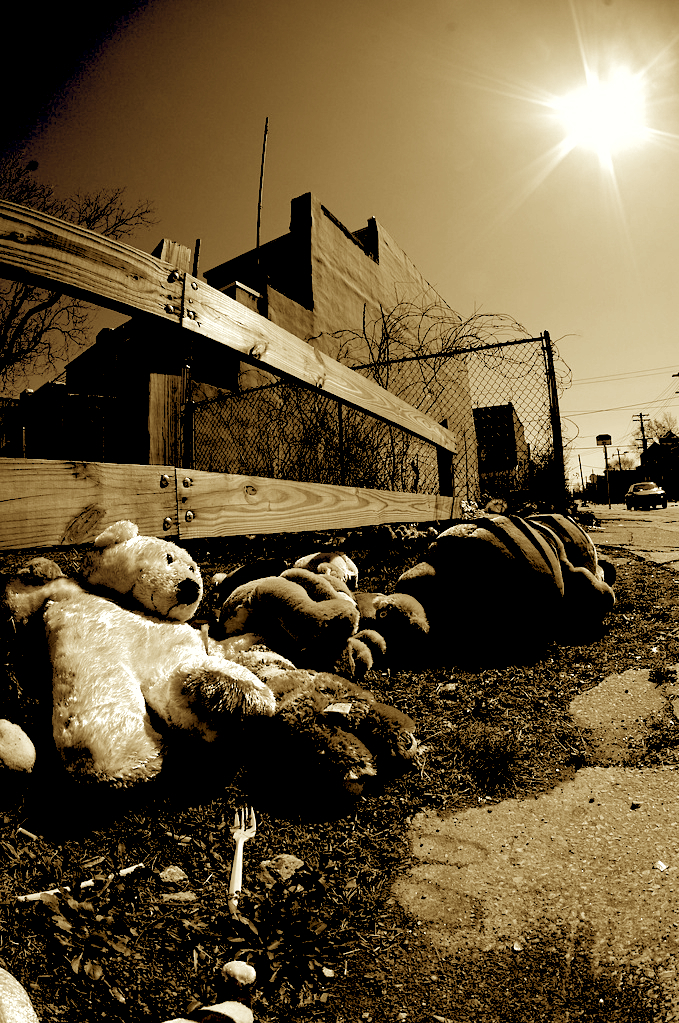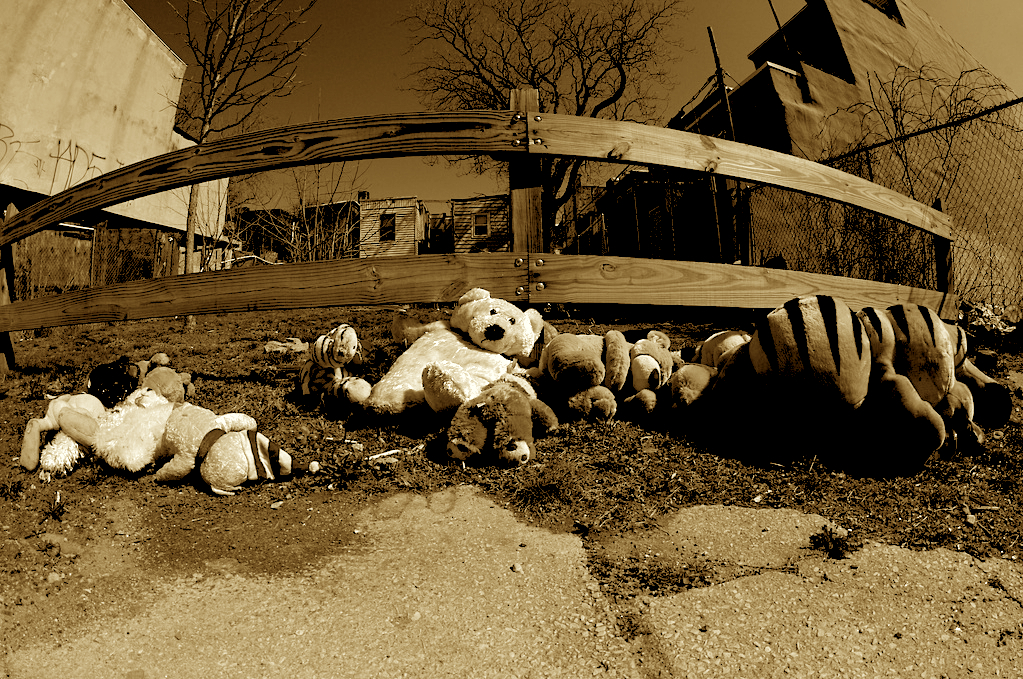
[Photos by JUSTIN ROMAN]
 BY JEFF DEENEY The small pile of stuffed animals on Berks Street, north of 31st, looks neglected even though it’s only been there about three weeks. Some of the dolls are scattered, resting in the garbage-strewn grass plot across the street from the tiny Pleasant Oak Missionary Church. It’s impossible to know whether this memorial, marking a murder that happened back in February, was kicked over or was simply blown askew by a strong wind. These dolls aren’t covered in loving messages from friends and family members like I’ve seen at other sites, and there are fewer of them. This is a small display of sympathy, one with a feeling of sadness more than modesty.
BY JEFF DEENEY The small pile of stuffed animals on Berks Street, north of 31st, looks neglected even though it’s only been there about three weeks. Some of the dolls are scattered, resting in the garbage-strewn grass plot across the street from the tiny Pleasant Oak Missionary Church. It’s impossible to know whether this memorial, marking a murder that happened back in February, was kicked over or was simply blown askew by a strong wind. These dolls aren’t covered in loving messages from friends and family members like I’ve seen at other sites, and there are fewer of them. This is a small display of sympathy, one with a feeling of sadness more than modesty.
Around the corner on 31st and Napa streets is another memorial, this one in graffiti on the broadside of an abandoned building. It reads, “In memory TJA,” and is undersigned by a long list of the deceased’s friends. It’s not surprising to find two memorials in close proximity in this part of town: There were four other homicides within two blocks of here in the past year, and at least as many shootings. This corner vies with the area around 29th and Dauphin, where Mook’s memorial still stands, for the dubious title of worst block in Strawberry Mansion.
Moments after we step out of the car, a shouting match erupts down the street. Two men to the south of us, closer to Montgomery Avenue, are nose-to-nose in the middle of the street, on the verge of throwing hands. Before the confrontation escalates one of the men storms off on foot while the other, wearing an olive-colored mechanic’s jumpsuit and straddling a BMX bike, pedals past us moments later still looking sour-faced and sore.
After we finish taking photographs of the neighborhood we’re approached by an odd couple. One is an aged Rasta whose long, yellowing gray beard is twisted into thick dreads and the other is a young woman in tight designer jeans, an equally snug Ed Hardy hoodie and a set of brown aviator shades whose tint hides her eyes and matches her metallic lip gloss.
The Rasta holds out a sheet of paper for me, explaining in his thick accent that a neighborhood woman saw us taking pictures and wanted me to have it. The flyer is titled, “Stolen Dreams” and bears a Xeroxed photo of a smiling young black man in a button-down shirt. The flyer announces the third anniversary of the death of William “Billy” Ward. Billy was a Strawberry Mansion homicide victim in 2005, shot multiple times, including a shot to the head, a couple of blocks away near 29th and Diamond. His family holds an annual Easter egg hunt in his honor; this year councilman Darryl Clarke is the guest speaker.
pictures and wanted me to have it. The flyer is titled, “Stolen Dreams” and bears a Xeroxed photo of a smiling young black man in a button-down shirt. The flyer announces the third anniversary of the death of William “Billy” Ward. Billy was a Strawberry Mansion homicide victim in 2005, shot multiple times, including a shot to the head, a couple of blocks away near 29th and Diamond. His family holds an annual Easter egg hunt in his honor; this year councilman Darryl Clarke is the guest speaker.
While I read over the flyer, the Rasta begins to tell me how he was once a victim of police brutality and how the criminalization of marijuana is ruining the lives of young black men, making it impossible for them to find decent jobs once they’ve been locked up on petty weed charges.
I ask the Rasta man and the woman hanging out with him about the memorial. The question gets a visceral response; the woman, who wants to go only by her first name Germaine, seems taken aback that I would even ask about it.
“I can’t believe there are memorials like this for people who rob and beat people up,” she says, waving dismissively at the pile of stuffed animals. “They put this dumb shit out for that kid, man, he just beat this one dude up last month, beat him up bad. He robbed a lot of people around here. He took a lot of wallets, took bikes from the kids.”
The Rasta chimes in to back up Germaine’s claim, assuring me that this is one bad dude we’re talking about.
Does Germaine think the young man’s murder was an act of retaliation? She says doesn’t know about that, but knows that the kid involved, 20-year-old Dontea Hart, from nearby Corlies Street, did have a lot of enemies.
I ask Germaine what drives the violence in the Strawberry Mansion and she cites addiction — not just addiction to drugs, she alludes to a broader debasing hunger that can drive men to murder.
“Some of these kids out here is addicted to money. Shit, I’ve known men who was addicted to pussy, even addicted to the titty bar. Weed, pills, whatever your thing is, man,” she says, smiling wickedly, “everybody’s got something they got to have.”
A search of court records proved unhelpful in verifying Germaine’s portrayal of neighborhood boy Dontea Hart. He had no adult criminal history at the time of his death.
ABOUT THE AUTHOR: Jeff Deeney is a freelance writer whose work has appeared in PW, City Paper and the Inquirer. He focuses on issues of urban poverty and drug culture.
